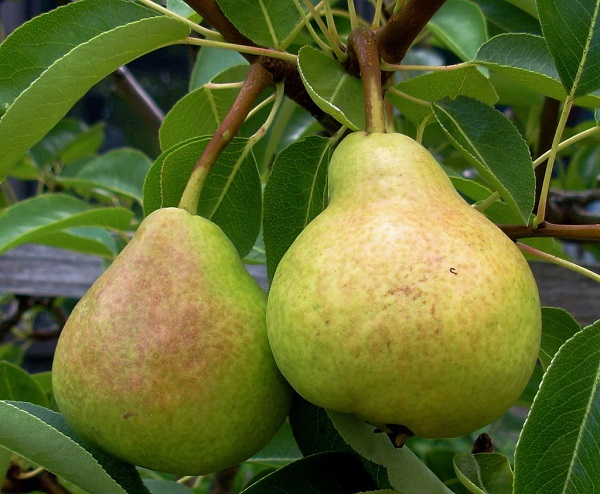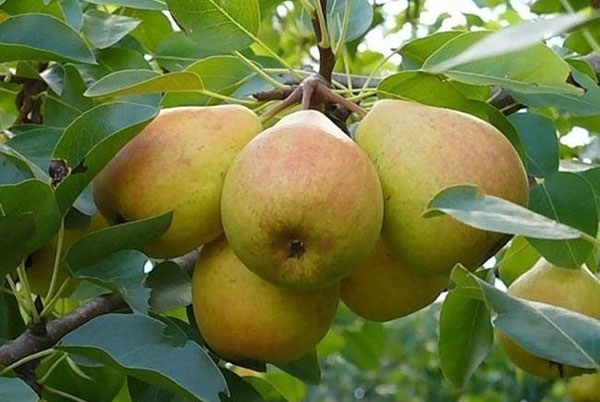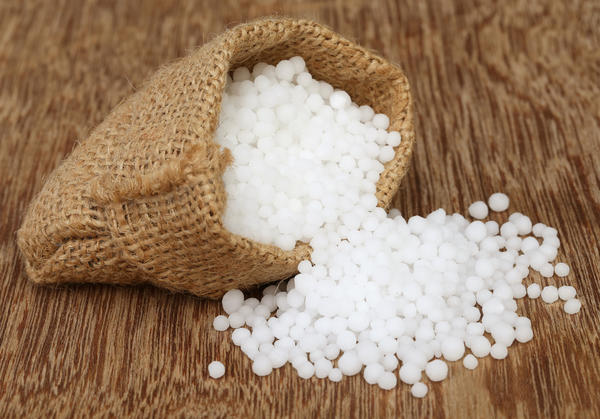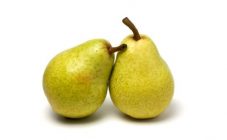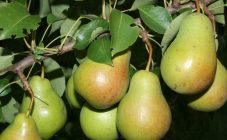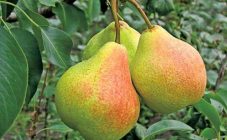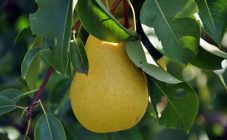Content:
Variety selection plays an important role in growing crops. The assortment of pears is regularly updated with new high-quality varieties from leading Russian and foreign breeding institutions. One of them is the Veles variety, which will be discussed below in the article.
Variety history
Pear is a fruit crop from the Pink family, one of the most widespread in the world. There are both arboreal and shrub varieties of culture. The fruits have a sweet rich taste, for which the pear is appreciated. Some people grow the culture for decorative purposes.
Veles pear belongs to varieties that ripen in autumn. She is also often referred to as the Excellent Daughter. The variety was obtained in VSTISP (Moscow) as a result of purposeful hybridization of the varieties Venus and Lesnaya Krasavitsa. The authors of the variety are breeders G. I. Petrov and N. V. Efimova. In 2001, the Veles variety was included in the State Register of Breeding Achievements. Today, it is most often found in the gardens of the Moscow region and neighboring regions.
Pear Veles: description
Trees of medium size, reach a height of 3-4 m. In the first years, the crown is spreading, gradually turning into a wide pyramidal one. The foliage is thickened at a medium level. The main branches are long and thick with a curved shape. Fruiting occurs on large annelids, evenly distributed along the stem.
The shoots of the variety are medium in size, brownish-brown, thickened. Leaves with a smoothed surface, rich green, finely serrated, serrated at the edges. Petioles are elongated and thin.
The average fruit weight of the variety varies from 150 to 180 g, the largest reaches 200 g. Fruits are broadly pear-shaped, symmetrical, without pronounced ribbing. The rind is smooth and even. The main color is green-yellow, the integumentary color is a weak reddish bloom. The stalks are elongated, curved and of medium thickness.
The pulp is creamy in color, semi-oily, medium density. The taste is sweet and sour, juicy and delicate. The variety is predominantly of a dessert type, but the fruits can also be used for technological processing. Plants begin to bear fruit for 5-7 years when grown in a nursery. The harvest is excellent and abundant, formed annually.
The variety is partly self-fertile, therefore it is recommended to plant several pollinators next to it. For this, pear varieties such as:
- Chizhovskaya;
- Autumn Yakovleva;
- Rogneda;
- Severyanka;
- Prominent.
Growing pears
Choosing a landing site
Pear Veles prefers well-lit areas. This is due to the increased thermophilicity of the variety. In such conditions, the fruits will be able to form a sufficient level of sugar content. Open areas are undesirable, since strong wind can injure young, immature seedlings. Well suited plot not far from the house, which would be well lit.
Both spring and autumn planting are practiced. The advantages of the first method are that during the season the plant will form a full-fledged root system, which promotes good wintering. In addition, in this case, the seedlings of the variety will not be damaged by rodents, which facilitates maintenance.However, in this case, the planting hole has to be prepared in the fall, since when planting in a freshly dug hole, the soil crumbles, which will negatively affect the plant.
In autumn Velesa is planted in the second half of September or 2 weeks before the start of frost. The hole for the variety should also be prepared in advance so that the seedling has time to take root normally and does not suffer from frost.
The variety grows well on various types of soil, including clay soils with a deficiency of nutrients. However, for best efficiency, it is recommended to choose the most fertile soils for it.
Landing
The efficiency of growing the Veles variety depends on the quality of the planting material. It should be 1-2 years old. The seedling should look healthy in appearance, without symptoms of diseases or mechanical damage. The leaves should have a natural green color, and the veins should be clearly visible on the underside of the leaf blade. The root system should be gray or brown without disease symptoms.
The size of the planting hole for the variety is determined depending on the size of the seedling. However, it makes no sense to make an overly voluminous hole; instead, it is easier to trim the roots a little. The depth of the hole should not exceed 50 cm. Its bottom is covered with a layer of manure or peat, which is mixed with the soil.
In order for the earth to settle better, the gardener must pour a bucket of water into the hole 1. After that, a wooden oblong peg is driven into the center of the hole with its sharp end down. Its height should be at the level of 120-150 cm. The seedling of the variety is placed in a hole and covered with earth so that the root collar is 6-8 cm above the soil level. The plant is tied to a peg and a shallow groove is dug around it, where about 20-30 liters of warm settled water is poured. Immediately after this, the groove is mulched so that moisture remains in the soil for as long as possible.
Irrigation
Young seedlings of the variety need frequent watering. The best option for them is two or three watering per week with 2 buckets of settled water.
An adult plant is watered once a week using small amounts of water. The pear is heavily watered twice a season: before entering the flowering phase and before the start of fruit formation. Should not be transfused. Plants have a sufficiently powerful and voluminous root system in order to extract moisture from the soil. After each irrigation, it is necessary to loosen the soil in the near-trunk circle for better saturation of the root system with oxygen and moisture and simultaneous removal of weeds.
Top dressing
The Veles variety needs three times the introduction of nutrients during the growing season. The first of them is carried out before the beginning of the flowering phase. As a top dressing, nitrogen fertilizers are used - nitrate or carbamide.
Then another top dressing is carried out. To do this, a shallow trench is dug around the plant, where organic substances mixed with the soil are introduced:
- manure;
- grass;
- food waste;
- foliage.
Then all this is buried. By the end of autumn, organic matter will decompose, and plants will receive an additional source of energy.
In the second decade of September, the final feeding of the season is usually carried out. In this case, ash or sawdust is used. It is prohibited to use nitrogenous substances.
Pruning
In the first 2 years, no pruning is carried out on the pear. At this time, the tree is growing its crown, the removal of branches will only slow down this process. In the third year, first of all, you need to remove shoots growing at right angles.They rarely bear fruit, and they create excessive shade for the entire crown. All other branches are left, but cut by about a third. The central branch is also shortened, but it should still rise 25-30 cm above the rest of the shoots. The next year, young branches are cut in the same way.
Sanitary pruning should also be carried out annually. It consists in cutting out dried, diseased, injured branches.
Plant protection
The main ailment from which the Veles pear suffers is powdery mildew. Before budding, the tree is sprayed with scor or topaz fungicides. At the end of flowering, home is brought in, and in the fall, when the harvest is harvested, the plant is treated with copper sulfate.
The Veles variety is often affected by fruit rot. To protect against it, hom is used before the beginning of the flowering phase, and after it - oxych.
They get rid of bacterial burns on the variety with the help of homa or a solution of copper sulfate. Sick stems and foliage must be collected in a timely manner and burned on the spot, without taking them outside the site. This will stop the spread of the infection.
The main harmful insects affecting the variety are:
- hawthorn;
- honeydew;
- moth.
To destroy these pests, insecticides are used such as:
- entobacterin;
- karbofos;
- hom;
- vermitek;
- apollo.
Harvesting
The Veles variety is characterized by uniform simultaneous fruiting, but, despite this, it is recommended to collect the fruit in two passes. The first in the last decade of August, collecting the largest fruits. All the rest are collected on a second run in mid-September. It is best to pick slightly unripe pears as they last longer.
Preparing for winter
Despite the relative winter hardiness, additional protection of the pear from frost will always come in handy. First of all, you need to remove foliage from the trunk circle in the fall and dig it up carefully. Mummified remains of fruits often remain on the stems, and they should also be disposed of in order not to breed diseases and pests on the plot.
Advantages and disadvantages of the variety
The Veles pear variety is characterized by the following positive properties and qualities:
- adaptability to different cultivation conditions;
- high productivity;
- resistance to scab and other fungal diseases;
- regular fruit formation;
- high taste and marketability of pears.
The variety also has certain disadvantages:
- crushing fruits with a good harvest, as well as in the absence of pruning and on over-grown plants;
- insufficient winter hardiness of flower buds;
- relatively late period of entry into fruiting.
The Veles variety is very promising for cultivation both in industrial production and in dachas and personal subsidiary plots. It is also of considerable interest for research in breeding for winter hardiness, frost resistance, and self-fertility.
